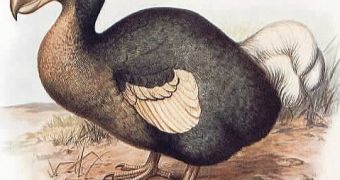You may have heard since childhood about the legendary bird Dodo from the book "Alice's Adventures in the Wonderland". But dodo (Raphus cucullatus) is not a legend at all. It was an enormous flightless bird, 23 kg (50 pounds) heavy and 1m (3 ft) tall that lived on the islands of Mauritius. It ate fruit and nested on the ground.
Since the mid-to-late 17th century, the bird is extinct, being the classical example of how humans and their accompanying cocktail of domestic and commensal species (dogs, pigs, cats, rats and in this case also crab-eating macaques) wiped out a species from the face of the earth. In fact, in the case of dodo, people seem not to have had a "taste" for its flesh; apparently, pigs and macaques have massively damaged the birds' nests, with a more severe impact than hunting had.
Now, the remains of a dodo discovered in a cave beneath bamboo and tea plantations in Mauritius could deliver the best chance yet to learn about the extinct mysterious bird. The finding was made earlier this month in the Mauritian highlands but the location was maintained secret until the complete recovery of the skeleton, nicknamed "Fred", on Friday. Four men guarded the site overnight.
"The remains are likely to yield excellent DNA and other vital clues, because they were found intact, in isolation, and in a cave. The geneticists who want to get their hands on this will be skipping down the street," Julian Hume, a paleontologist at Britain's Natural History Museum, told Reuters.
"Given the nickname "Fred" after the 65-year-old who found them, the remains should provide the first decent specimens of dodo DNA. Then you can work out how it actually got to Mauritius, because it must have originally flown here before evolving into flightlessness and the big, fat bird that we know. We know it's a giant pigeon. It is the first discovery of dodo remains away from the coastal regions, suggesting that the bird, extinct since the 17th century, lived all over the Indian Ocean island," he said.
But the new bones won't make a museum exhibit. "The remains are highly fragile. If you try and pick it up, it just falls apart. You won't see a mounted, beautiful thing from this," explained Hume.

 14 DAY TRIAL //
14 DAY TRIAL //